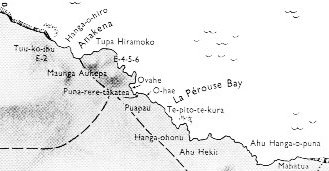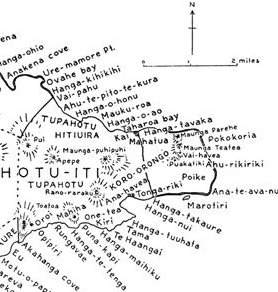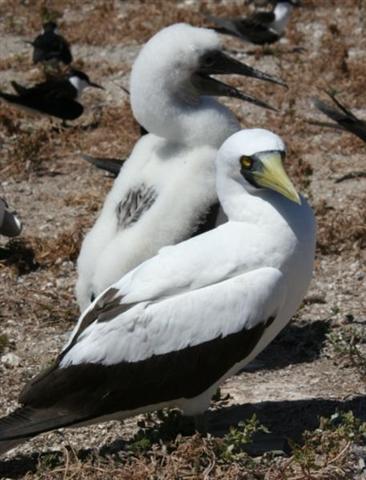5. Page number 42 has 4 stations in 6 text lines and
then there are 11 further lines:
|
42) |
|
57 |
hanga piko
a hare rutu manu a ana onono a Pu ngotangota. |
|
58 |
ata Popohanga
toou e to ata hero e |
|
59 |
ata ahiahi
toou e honu e |
|
60 |
apina nui
a
Papa nihoniho a vere nua(-) |
| |
nua a Papa o
rae i te ngao o te moai o hina(-) |
| |
riru |
|
ku
noho era a a Ira.i apina nui.i tuu mai |
|
ai.a a makoi.ki apina nui.he nape e Ira |
|
i
te ingoa.ko apina nui a Papa nihoniho |
|
a
vere nuanua a Papa o rae i te ngao o te |
|
moai o hinariru. |
|
ina kai hakamaa Penei e ku naa ana te moai |
|
te
tuitui reipa. |
|
he
hoki he oho mai arurua.he oo ki roto ki te ana |
|
he
noho.he too mai a Ira.i te hau mo te kaikai |
|
mo
uru.mo hakamaa i a Makoi.i te urunga o te kai(-) |
|
kai. |
4 stations probably means 40 days, and we can summarize the calendar of Makoi:
|
38) |
|
10 |
Apina
Iti |
40 |
Okahu |
|
20 |
Hanga
O Uo |
50 |
Ra
Tahai |
|
30 |
Hanga
Roa |
60 |
Ahu
Akapu |
| |
70 |
Kihikihi Rau Mea |
|
80 |
Renga
A Tini |
|
90 |
Vai
A Mei |
|
100 |
Rua A
Ngau |
|
110 |
Roro
Hau |
|
120 |
Vai
Poko |
|
130 |
Te
Hereke (17) |
|
39) |
|
140 |
Hatu
Ngoio |
170 |
Opata
Roa |
270 |
Hanga
Nui |
|
150 |
Ara
Koreu |
180 |
Vai
Tara |
280 |
Tongariki |
|
160 |
Hanga
Kuokuo (20) |
190 |
Hia
Uka |
290 |
Te
Rano A Raraku |
| |
200 |
Hanga
Ohiro |
300
|
Oparingi |
|
210 |
Roto
Kahi |
310 |
Motu Kumu
(36) |
|
220 |
Papa
Kahi |
|
|
230 |
Puna A
Tuki |
|
240 |
Ehu |
|
250 |
Maunga
Teatea |
|
260 |
Te
Hakarava (31) |
|
40) |
|
310 |
Oparingi
|
360 |
Hanga
Tetenga |
|
320 |
Motu
Humu |
370 |
Ahu
Tutae |
|
330 |
Hanga
Maihiku |
380 |
Oroi
|
|
340 |
Maunga
Toatoa |
390 |
Akahanga |
|
350 |
Te
Pipi Horeko (41) |
400 |
Hua
Reva |
| |
410 |
Rua
Hana |
|
420 |
Puku
Hotake |
430 |
Vai Ngaere
(53) |
|
41) |
|
440 |
Teho |
510 |
Rano Kau |
|
450 |
Vai
Ngaere |
520 |
Mataveri
O Uta |
|
460 |
Renga
Havini |
530 |
Mataveri
O Tai |
|
470 |
Hare
Hakangaengae |
540 |
Vai
Rapa |
|
480 |
Hanga O
Maru |
560 |
Te
Vai Rutu
Manu (71) |
|
490 |
Maunga
Marengo |
|
|
500 |
Hanga
Te
Pau (60) |
|
42) |
|
570 |
Hanga
Piko (73) |
580 |
Ata Popohanga |
600 |
Apina
Nui (78) |
| |
590 |
Ata Ahiahi |
|
I have interpreted Capital Letters to indicate
a new beginning, which in page 42 results in Ata Ahiahi being grouped
together with Ata Popohanga. Considering the Venus cycle
which has 584 nights it seems natural to let these pair of stations
belong in a group, capturing so to say the end of the Venus cycle.
But then Makoi in day position 24 should
also mark such a new beginning:
|
10 |
ko
apina iti.ko
rapa kura.he oho mai he |
|
20 |
tuu ki
hanga o uo.he nape i te ingoa.ko
hanga o uo |
| |
a vave
renga. |
|
24 |
he
nape he oho a
Makoi
.i te ingoa.ka vari ro. |
| |
a
arurua.aro i apina nui i hakatuu ai |
|
28 |
te
maea.etahi no raa.i nape i oho ai. |
|
30 |
hanga
roa a
tuki tukau |
|
40 |
Okahu
a uka ui hetuu. |
|
50 |
ra
tahai
a uo. |
|
60 |
ahu
akapu a
mata kurakura. |
|
70 |
kihikihi rau mea
a rapa rau renga |
|
80 |
renga
a tini a
toto renga |
|
90 |
vai a
mei u(h)i
kapokapo. |
|
100 |
rua a
ngau a
nua ngirongiro. |
|
110 |
roro
hau a
mana ai rea. |
|
120 |
vai
poko aa
raa mata turu |
|
130 |
ko
te hereke
a kino ariki |
This break in time can explain what otherwise would
be dismissed as a 'typographical error', viz. the gap between
Makoi and the following full stop sign.
Let us conclude this short overview of Makoi's
list by returning to page 40:
|
40) |
|
310 |
Oparingi
|
360 |
Hanga
Tetenga |
|
320 |
Motu
Humu |
370 |
Ahu
Tutae |
|
330 |
Hanga
Maihiku |
380 |
Oroi
|
|
340 |
Maunga
Toatoa |
390 |
Akahanga |
|
350 |
Te
Pipi Horeko (41) |
400 |
Hua
Reva |
| |
410 |
Rua
Hana |
|
420 |
Puku
Hotake |
430 |
Vai Ngaere
(53) |
Te Pipi Horeko is the end of a group, and the
'cave' of Kuukuu is probably located at day number 12 * 29.5
+ 1 = 355. This ought to be equivalent to the kuhane
station Hatinga Te Kohe:
 |
 |
 |
 |
 |
| Gb4-18 |
Gb4-19 |
Gb4-20 |
Gb4-21 |
Gb4-22 |
 |
 |
 |
 |
 |
|
Gb4-23 |
Gb4-24 |
Gb4-25 |
Gb4-26 |
Gb4-27 |
 |
 |
 |
 |
 |
|
Gb4-28 |
Gb4-29 |
Gb4-30 |
Gb4-31 |
Gb4-32 |
 |
 |
 |
 |
 |
|
Gb4-33 |
Gb5-1 (355) |
Gb5-2 |
Gb5-3 |
Gb5-4 |
Hau tea in Gb5-1 is reversed to show a
break in time, where darkness arrives. The old year is finished and we could
therefore be at
Anakena:

Because the explorers left Kuukuu after 27
days at the kuhane station 24 Oromanga. Yet the
kuhane station 10 Hatinga Te Kohe is located on the
southern coast:

This is no contradiction because the international
date line is also a vertical line marking a break in time. A
vertical line marking the break in time between an old and a new
year could very well be drawn between Anakena and Hatinga
Te Kohe (about where the dotted line on the map of Métraux is
drawn).
Moon (the kuhane of Hau Maka) moves
from west to east along the southern coastline and Sun (Kuukuu)
moves from east to west along the northern coastline. Both should
encounter the 'date line', although from opposite directions and at
different latitudes.
Although there is a seabird named kena, what
comes out from the 'cave' (ana) at Anakena is probably
something else, viz. a red-hot newborn Sun personifying the new
year:
| Kena A sea bird, with a white breast and black wings,
considered a symbol of good luck and noble attitudes. Mgv.: kena, a white seabird. Mq.: kena, a
large bird.

Mq.: kena, burning, very hot. Ha.: ena,
red-hot, to burn as a fire. |











